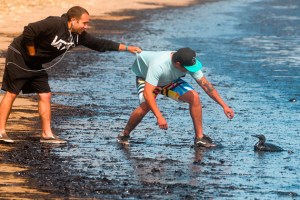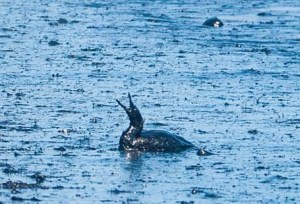A cleanup effort was underway Wednesday at Refugio State Beach in Santa Barbara County, where an oil spill from a nearby pipeline left the sand polluted and created two separate slicks stretching across 9 miles of the Pacific Ocean and totaling up to a “worst-case scenario” of up to 105,000 gallons.

The leak, located along an underground pipe that is part of a larger oil transportation network, was stopped Tuesday afternoon after crude oil poured onto the surrounding ground, down a canyon, under a culvert and onto the sand and into ocean.
Early Wednesday evening, Gov. Jerry Brown declared a state of emergency in Santa Barbara County to help make resources available more quickly for the massive cleanup operation.
The head of the Houston-based company that operates the 24-inch pipeline apologized for the release.
“We deeply, deeply regret that this incident has occurred at all,” said Plains All American Pipeline President and CEO Greg Armstrong. “We apologize for the damage that it’s done to the wildlife and the environment, and we’re very sorry for the disruption and inconvenience it has caused.”
Armstrong said the company was committed to restoring the site to “normal,” and planned to work around the clock to support the cleanup.
Two county supervisors who spoke at a Wednesday morning news conference with a group of local, state and federal officials said the spill was more than an inconvenience.
“This is devastating news to all of us who live in recreate in this county. This is a disaster,” said Janet Wolf, chairwoman of the Santa Barbara County Board of Supervisors. “It’s a worst nightmare scenario.”
Santa Barbara was the site of the third-largest oil spill in U.S. history — a 1969 incident that left the scenic coastline blackened and galvanized the young environmental movement.
Pipeline officials said analysis showed up to 2,500 barrels, or 105,000 gallons, could have spilled under a “worst-case scenario.”
About 500 barrels, or 21,000 gallons, were thought to have gone into the ocean. Both spill figures were still under investigation, the Joint Information Center for the Refugio response stated.
The Las-Flores-to-Gaviota pipeline — Line 901, built in 1987 — can transport up to 150,000 barrels, or 6.3 million gallons, of crude oil on an average day, and typically sends about 1,300 barrels through per hour, according to authorities and pipeline officials.

It was not yet known what exactly caused the leak, pipeline officials said.
A preliminary investigation showed mechanical issues occurred at 10:45 a.m. at the Las Flores pump station, prompting the line to be shut down, according to Rick McMichael of Plains All American. The pumps were restarted within 10 minutes, he said. Then, another pump at the Sisquoc station went down at 11:15 a.m. The pipeline was shut down at 11:30 a.m., and one hour later, the company heard from a local first responder with reports of an odor, McMichael said.
A company employee dispatched to the area confirmed the release of crude oil at 1:30 p.m.
The pipeline had been inspected about two weeks earlier but results from those test were not yet available, Armstrong said. The company inspects the pipelines every three years, and the last previous inspection was in 2012, he said.
Michelle Rogow of the U.S. Environmental Protection Agency said the pipeline had been under the jurisdiction of the California Office of State Fire Marshal, but that authority was transferred to the U.S. Department of Transportation two years ago due to the state “dwindling resources.”
Beach cleanup began at first light Wednesday, when a strong, thick smell of crude remained and oil covered sand and rocks.
Some 73 crews worked to clean the beach, and three 65-foot vessels and six “boom vessels” were collecting oil as of 7:30 a.m., the Office of Spill Prevention and Response tweeted.
About 145 barrels — or 6,090 gallons — had been collected by 9 a.m.
Dozens of workers in white suits and masks could be seen going through rocks on the beach, video showed. More than 300 government first responders and contractors were on scene, and more were expected Thursday, ocean-based incident commander U.S. Coast Guard Capt. Jennifer Williams said.

“Oil recovering tends to be a complicated process that involves a lot of manual labor and taking environmental factors like wind, current and weather into consideration,” Williams said. “It can be a slow process, but we want to make sure we do it right so we can get the beaches back to its pristine condition.”
Williams said the Coast Guard had flown over the spill Wednesday morning and saw that two slicks had spread along the coastline, with one slick 2 miles from shore and about 3.7 miles long, and another 5.3 miles in length. The extent was greater than anticipated, she said.
The U.S. EPA was overseeing on-land cleanup, and Rogow asked the public to let experts do the work and remain away from the scene. A plan to remove oil from the culvert and uphill from the shoreline was expected to be in place on Thursday, according to Rogow.
Any oiled birds or wildlife can be reported to the state’s Oiled Wildlife Care Network at 877-823-6926, said Capt. Mark Crossland with the California Department of Fish and Wildlife.

“Although the response is going as well as planned, the fact is the spilled oil is difficult to contain and collect once it’s on the water,” Crossland said. “It’s likely there will be some environmental impacts, including oiled birds and oiled shoreline.”
The number of birds and marine creatures affected would not be available until crews were done with their work in the field, Crossland said.
Authorities gave no timeline for when cleanup would be completed, emphasizing their goal of returning the beach and water to its pre-spill condition.
A website was set up to provide information about the oil spill and cleanup at refugioresponse.com. Those who wished to volunteer were asked to call 800-228-4544.
The spill prompted the closure of a nearby campground, which was completely booked for the upcoming Memorial Day weekend holiday. A California State Parks officials said efforts were being made to contact those with reservations at Refugio and El Capitan State Beach, both of which were shut down.
Camping reservations at the two state beaches were canceled through May 28, California State Parks said on Twitter.
County Supervisor Salud Carbajal said the incident was a “serious ecological disaster.”
“This is devastating, not only to the environment and the sea life, and our birds and wildlife, but also to our economy,” Carbajal said. “We have Memorial Day weekend coming up and this park may be closed as a result of that.”
Though the smell of petroleum was expected to lurk in the air, the spill posed no danger to the public, according to the Joint Information Center. Air quality was being monitored.
Fisheries in the area were closed. A financial claims line was set up by Plains All American Pipeline at 866-753-3619.
More video:















